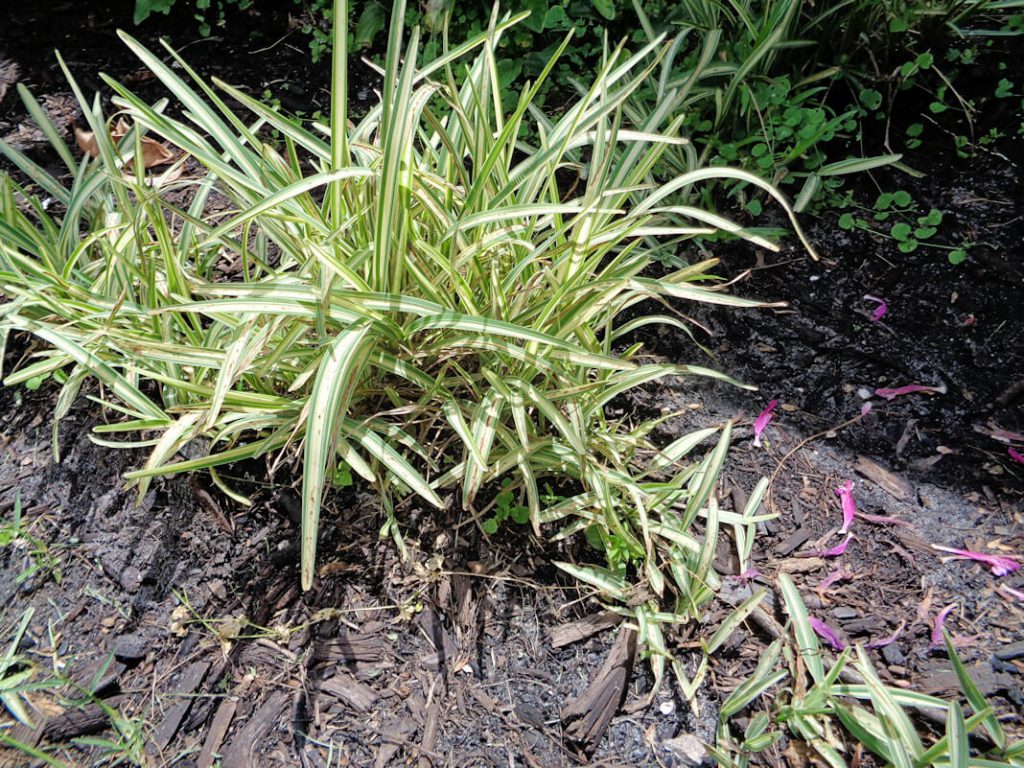
There are a plethora of variegated plants out in the gardening world that you may never have seen before. When a familiar green plant comes in a variegated form (white and green or cream and green), this change can jazz up its interest and maybe even cause it to be used it in a different, more ornamental planting arrangement. A selection of St. Augustine grass called Stenotaphrum secundatum ‘Variegata’ is such a cultivar. Imagine a St. Augustine grass stripped green and white reminding you more of a common spider plant or variegated liriope. Now, while you could probably have a whole lawn of this if you wanted, or even a small mini-lawn patch, it is so ornamental that using it in hanging baskets or in decorative pots really fits the bill.
I first heard about variegated St. Augustine grass years ago from a local nursery and I was intrigued. I did imagine a whole lawn of it but thought it might be more manageable in pots. I obtained some sprigs of this cultivar about twelve years ago from an on-line source and have been growing it ever since. Before we discuss the uses and propagation of variegated St. Augustine grass, let’s take a look back at the interesting history of this common warm-season turf and how we ended up with it in Florida. The literature indicates that St. Augustine grass is native to the Gulf of Mexico area, the West Indies and even Western Africa. As it is very salt-tolerant, St. Augustine has traveled around the tropics and was found in Uruguay, Brazil, Nigeria, Sierra Leone, Bermuda and even South Carolina prior to 1800. St. Augustine was later found in 1840 in both Australia and New Zealand. By the 1890’s, St. Augustine was introduced into Florida as a turf grass and a pasture grass. With a few exceptions, St. Augustine is a sterile grass that will not normally produce viable seeds, and as such, is propagated by vegetative means. The first sterile strain was found in South Africa and was an early unnamed cultivar. ‘Floratine’ and ‘Bitter Blue’ were some of the first named cultivars developed. ‘Floratam’, the well-loved cultivar developed by both Florida and Texas Experiment Stations, was released in 1972. There are other recognized cultivars including dwarf types.
Variegated St. Augustine grass is just one of those cultivars that had ornamental appeal and was eagerly propagated by horticulturalists. It roots easily from sprigs with sections of stolon – above ground running stems – where nodes are located. In a pot, the variegated St. Augustine develops a nice clump of foliage with runners spilling out of the container again reminding one of a spider plant. Variegated St. Augustine is a natural for hanging baskets and will provide an ornamental feature throughout the summer. Overgrown pots of this ornamental turf can be divided into sections and started in new pots. Variegated St. Augustine, planted in combination with other ornamental annual plants, can make a large planter the center of attention. Full sun is the preferred location for best color and growth. St. Augustine grass does best with supplemental watering, so make sure to keep this task in mind.
Again, one of the biggest questions is where do you find it? While this plant may be available from local family-run garden centers, there are many on-line sources for variegated St. Augustine grass – just do a quick search. Once you have some established plants, you will have plenty to share with your friends and neighbors! Try this stunning, easy-to-grow ornamental grass today! For more information on all types of ornamental plants suitable to grow in our area, or to ask a question, please visit https://www.facebook.com/CharlotteMGLifeline/ . Ralph E. Mitchell is the Director/Horticulture Agent for the UF/IFAS Charlotte County Extension Service. He can be reached at 941-764-4344 or ralph.mitchell@charlottecountyfl.gov.
Resource:
Duble, R. L. (2005) St. Augustine Grass. Texas AgriLife Extension Service, Texas A & M System.
 1
1

Comments are closed.